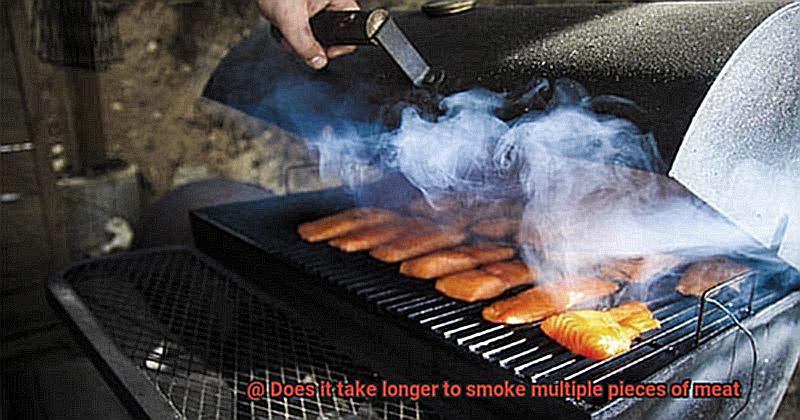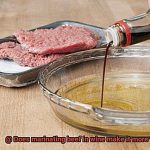Are you a barbecue fanatic, spending hours perfecting the art of smoking delectable meat? If so, you’ve probably wondered: does it take longer to smoke multiple pieces of meat? As a fellow lover of all things smoky and delicious, I’ve pondered this question myself. In this blog post, we’ll explore the ins and outs of smoking multiple cuts of meat and uncover the secrets behind achieving mouthwatering results.
Time is everything when it comes to smoking meat. Every pitmaster knows that different types and sizes of meat require specific cooking durations for that perfect tenderness and flavor. But what happens when you have multiple pieces on the smoker? Fear not. We’re here to guide you through this intriguing topic and ensure your next cookout is a triumph.
First things first – size matters. Smaller cuts like chicken wings or ribs may only need one to three hours in the smoker, while larger cuts like brisket or pork shoulder can demand a whopping fifteen hours or more. So, grouping your meats accordingly is key to ensuring each cut gets its fair share of time in the smoker.
But it’s not just about size; placement is crucial too. Piling meats too close together can hinder heat circulation, resulting in uneven cooking and potential delays. To avoid these mishaps, make sure there’s proper airflow within your smoker – it’s the secret sauce for even cooking and optimal timing.
And let’s not forget about temperature control. When you have multiple pieces on the smoker, the temperature may fluctuate slightly due to increased heat absorption. That means keeping a watchful eye on those dials and making necessary adjustments to maintain your desired range. Trust me; no one wants their mouthwatering masterpiece delayed by temperature hiccups.
In conclusion, smoking multiple pieces of meat indeed presents its unique challenges when it comes to time management. From considering the size and type of meat to arranging them inside the smoker, every detail impacts the cooking duration. But fear not, my fellow barbecue enthusiasts. By taking these factors into account and mastering temperature regulation, you’ll be well on your way to a successful cookout that leaves everyone craving more.
Stay tuned for the next section of this blog post, where we’ll dive deeper into specific techniques and tips to optimize your smoking experience. Get ready to elevate your barbecue game like never before.
Contents
What Factors Affect the Cooking Time of Multiple Pieces of Meat?
Cooking multiple pieces of meat to perfection can be a daunting task. To achieve culinary excellence, it is crucial to understand the factors that affect cooking time. By considering the size and thickness of the meat, the type of meat being cooked, the chosen cooking method, temperature control, and proper arrangement and rotation techniques, you can master the art of cooking multiple pieces of meat.
Size and Thickness:
The size and thickness of each piece of meat significantly impact cooking time. Thicker cuts require more time to cook through, while thinner pieces will cook faster. It is important to plan your cooking process accordingly and adjust timing to ensure even cooking.
Type of Meat:
Different types of meat have varying densities and fat content, which affect their cooking time. Poultry generally cooks faster than beef or pork. Meats with higher fat content, such as marbled steaks, take longer to cook due to the rendering and melting of fat. Understanding these characteristics helps estimate accurate cooking times.
Cooking Method:
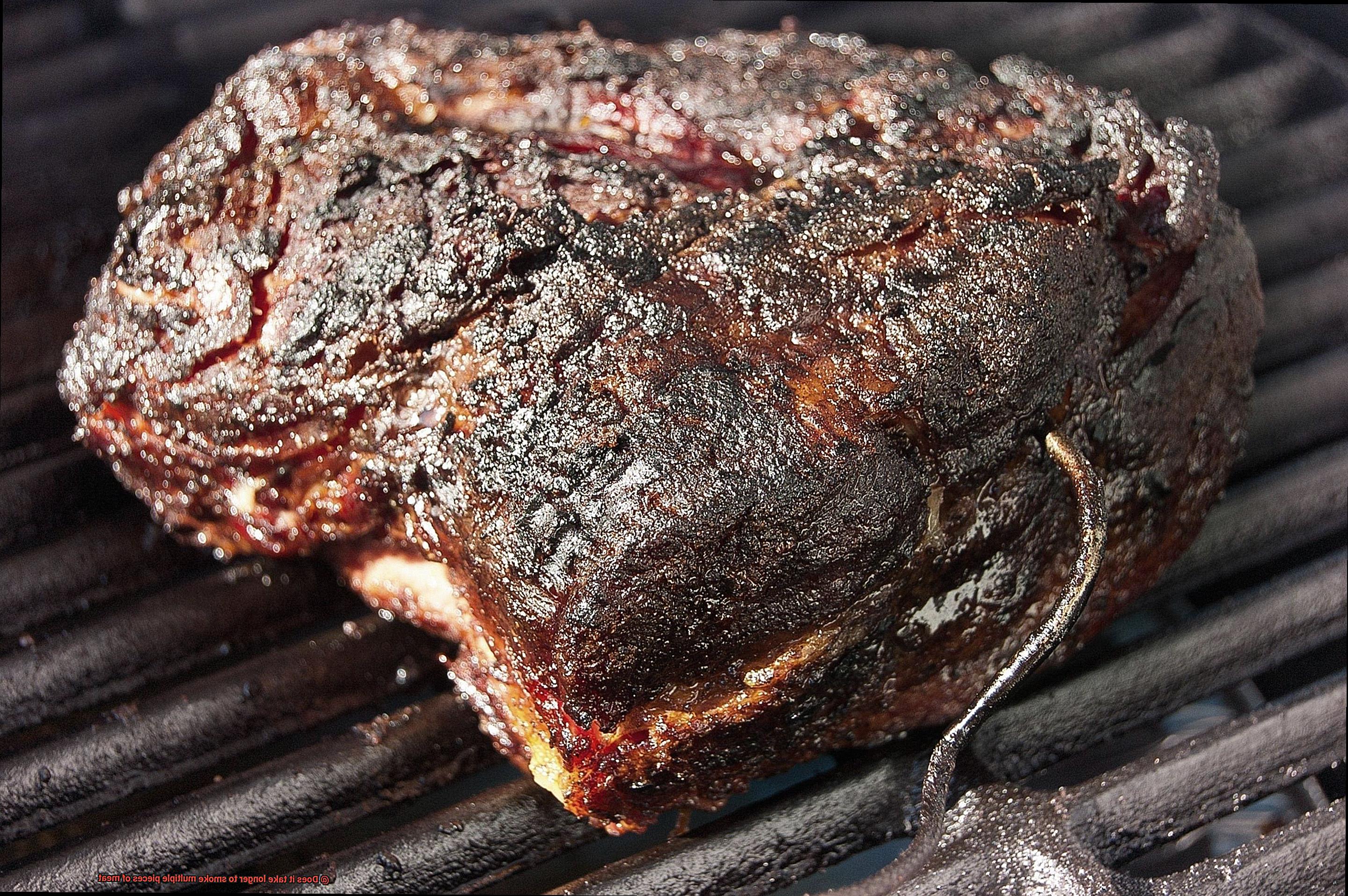
The chosen cooking method greatly influences cooking time. Grilling over high heat results in faster cooking compared to smoking at low temperatures. Roasting in the oven or using the sous vide method also have different cooking times. Familiarize yourself with various methods and adjust timing accordingly.
Temperature Control:
Consistent temperature control throughout the cooking process is crucial for even cooking. Fluctuations in temperature affect overall cooking time. Monitor and regulate the temperature of your cooking environment, whether it’s an oven, grill, or smoker, to ensure consistent results.
Arrangement and Rotation:
Proper arrangement and rotation techniques help promote even cooking when preparing multiple pieces of meat simultaneously. Arrange the meat to allow for proper air circulation and consider variations in size and thickness. Additionally, rotating or rearranging the meat during cooking ensures that each piece cooks evenly.
The Impact of Size and Thickness on Cooking Time
Today, we embark on a smoky adventure, exploring the intriguing world of smoking multiple pieces of meat. Get ready to unravel the secrets behind achieving mouthwatering results every time by understanding how size and thickness can impact cooking time. Prepare yourself for an exciting journey into the realm of perfectly smoked meats.
Size Matters:
Picture this: a massive beef brisket versus a petite chicken breast. When it comes to smoking meats, size truly matters. Larger cuts require more time to cook compared to their smaller counterparts. The heat needs ample time to penetrate through the glorious mass of a big cut, ensuring even cooking throughout. So be prepared to invest some extra time for those grandiose pieces.
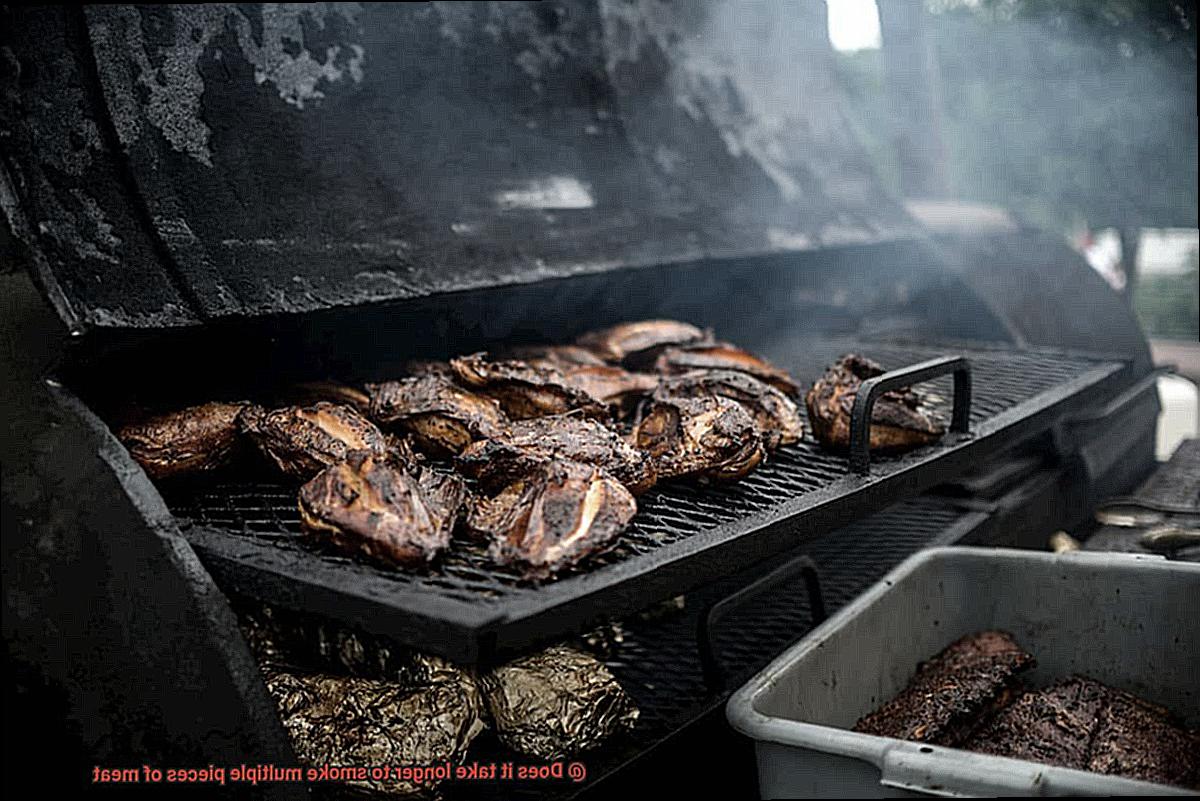
Thin vs. Thick:
Now, let’s dive into thickness. Thicker cuts demand a little more patience as they take longer to cook than their thinner counterparts. Imagine sinking your teeth into that juicy, thick ribeye steak, perfectly smoked to your desired doneness. Mmm, it’s worth the wait. So remember, when dealing with thicker cuts, allow yourself some extra time for that ultimate tenderness.
Smokin’ Multiples:
But what happens when you have multiple pieces of meat in your smoker? Brace yourself for an extended cooking time. When you load up your smoker with several cuts, they can create heat barriers and restrict airflow. This makes it trickier for the heat to reach each piece evenly. So exercise patience, my friends, as you navigate through the challenges of smoking multiples.
Reverse Searing: A Game-Changer:
Fear not. We have a trick up our sleeve called “reverse searing.” This technique involves smoking the meat at a lower temperature initially to infuse it with delicious smoky flavors. Then, towards the end, crank up the heat to develop that delectable crispy exterior we all crave. It’s like having the best of both worlds – tender and smoky on the inside, with a satisfying crunch on the outside.
The Power of the Meat Thermometer:
A trusty meat thermometer is an indispensable tool in your smoking arsenal. It becomes your guide to ensuring all your meat is cooked to perfection. By monitoring the internal temperature of each cut, you can eliminate any guesswork and achieve your desired level of doneness – no more undercooked or overcooked surprises. Let precision be your ally as you conquer the art of smoking.
As you embark on your grilling journey, remember that size and thickness are vital factors impacting cooking time when smoking multiple pieces of meat. By embracing techniques like reverse searing and using a trusty meat thermometer, you’ll unlock the secrets to creating tantalizing smoked meats that will leave your taste buds begging for more.
The Capacity and Efficiency of Your Smoker
Let’s begin by exploring the capacity of your smoker. How much meat can it handle? This crucial factor determines the number of pieces you can smoke at once. Smokers equipped with multiple racks or shelves are ideal for smoking larger quantities simultaneously. Conversely, if you possess a smaller smoker, you may need to smoke your meat in batches, which can elongate the process.
Efficiency is another crucial aspect to consider. A well-designed smoker is key to maintaining and regulating temperature throughout the smoking process. Top-notch insulation and a reliable heat source are essential. Whether you opt for charcoal, wood pellets, or electricity, ensure your smoker can consistently reach and maintain the desired temperature. This way, it matters not whether you’re smoking one piece or a multitude – your results will be consistently mouthwatering.
Proper spacing and arrangement of your meat inside the smoker are crucial for even cooking. Adequate airflow guarantees that each piece gets smoked evenly. Overcrowding your smoker with too many pieces risks uneven cooking and extended smoking times.
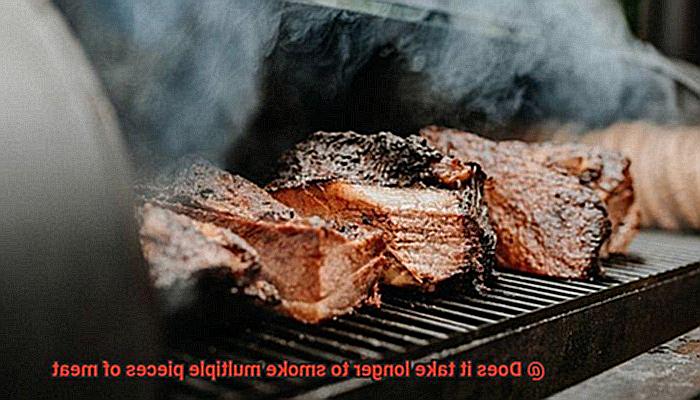
The type of smoker you employ also affects efficiency. Offset smokers, with their separate fireboxes, may necessitate more monitoring and adjustments when smoking multiple pieces. Electric smokers, on the other hand, boast precise temperature controls and consistent heat distribution, making them efficient for smoking several pieces concurrently.
Lastly, consider the size and thickness of your meat pieces. Thicker cuts or larger pieces naturally require more time to reach the desired internal temperature. Therefore, if you’re smoking multiple thick cuts simultaneously, it may take longer compared to smaller or thinner cuts.
Different Types of Meat Require Different Cooking Times
Smoking meat is an art form that requires precision and patience. To achieve mouthwatering results, it’s essential to understand that different types of meat require varying cooking times.
In this article, we will delve into the reasons behind these variations and provide valuable tips to ensure your smoked meats are cooked to perfection.
The Influence of Meat Characteristics:
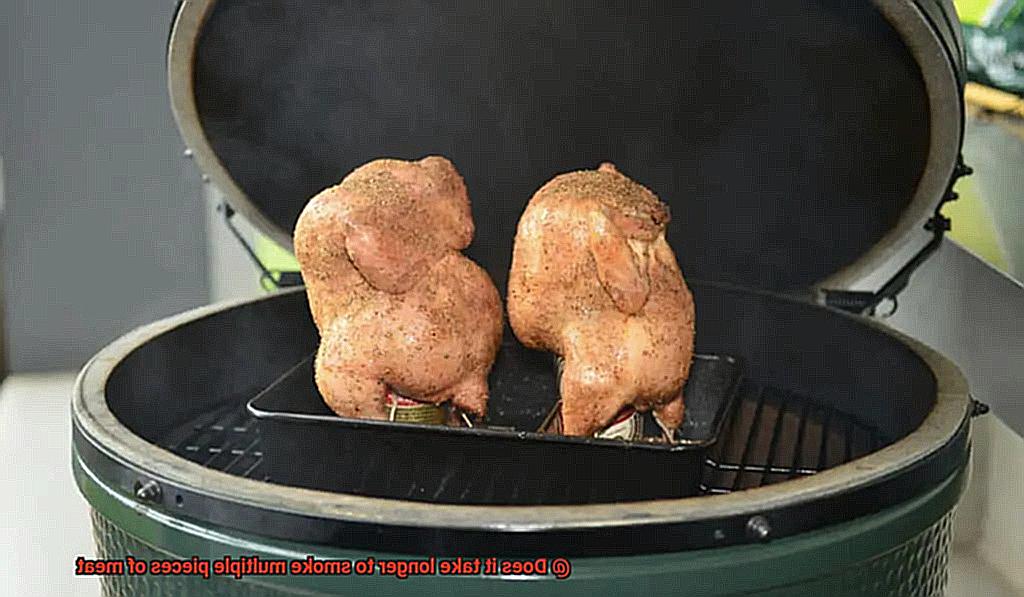
Meat is a diverse world of flavors and textures. Each type of meat has its own unique characteristics that dictate its cooking time. For example, beef brisket is a tough cut that requires a longer cooking time to break down connective tissues and achieve tenderness.
The low and slow smoking process allows the collagen in the meat to transform into gelatin, resulting in succulent, fall-off-the-bone brisket. On the other hand, pork ribs are smaller and have less connective tissue, which means they require a shorter cooking time for optimal juiciness.
Size Matters:
When it comes to smoking meat, size matters. Thicker cuts take longer to smoke compared to thinner ones. The thickness of the meat influences how long it takes for heat and smoke to penetrate the center. To ensure even cooking, it’s crucial to select cuts that are relatively similar in size when smoking multiple pieces of meat.
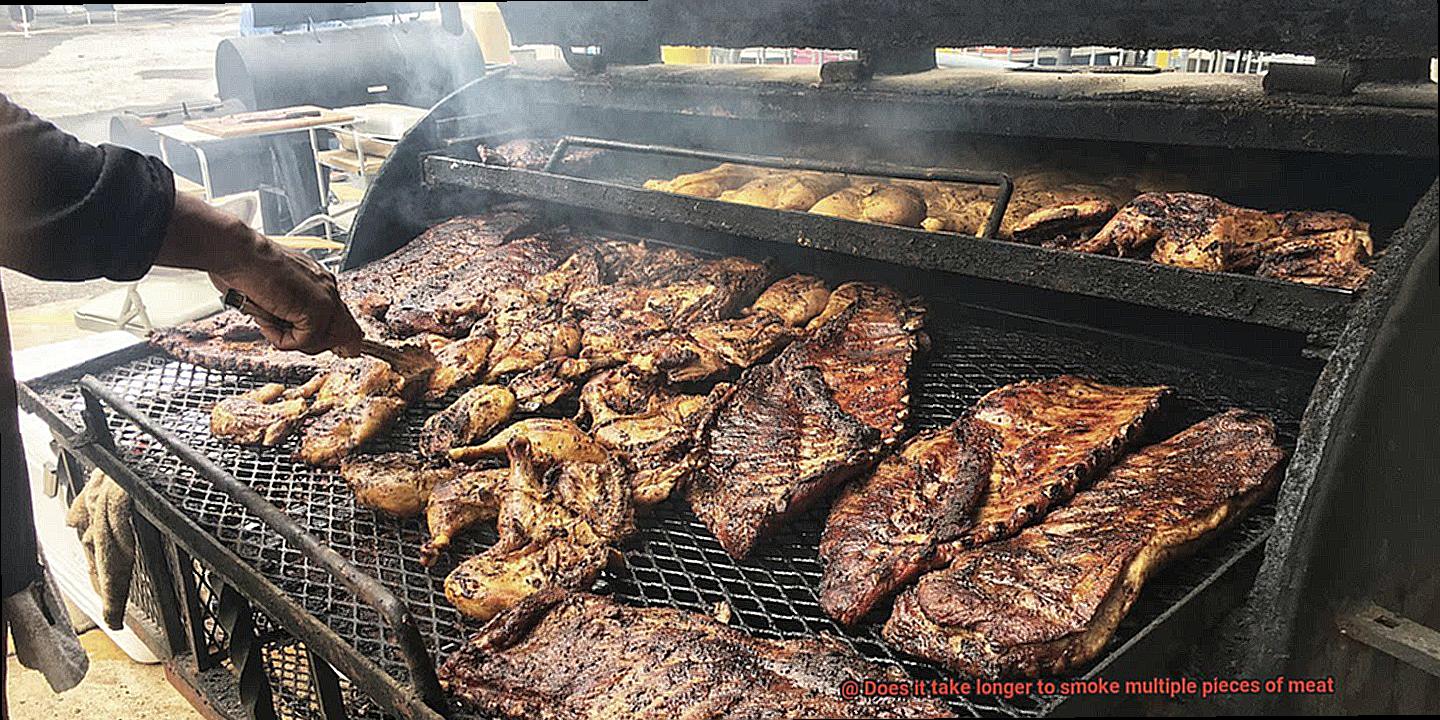
The Role of Fat Content:
Fat is not just a flavor enhancer; it also affects cooking time. Fattier cuts, such as pork shoulder or beef ribs, take longer to cook as the fat needs time to render and contribute to flavor and tenderness. The slow smoking process allows the fat to melt, infusing the meat with moisture and richness. Conversely, leaner meats like poultry cook faster due to their lower fat content.
Moisture Content and Muscle Density:
Moisture content and muscle density can significantly impact cooking time. Meats with higher moisture content, like chicken or turkey, tend to cook more quickly than those with lower moisture content, such as beef or pork. The moisture in the meat helps conduct heat more efficiently, resulting in faster cooking. Additionally, muscle density plays a role in cooking time. Tougher muscles require extended cooking to break down collagen and become tender.
The Importance of Internal Temperature:
When smoking meat, achieving the proper internal temperature is crucial for both flavor and safety. Different types of meat have different recommended internal temperatures. Using a reliable meat thermometer allows you to monitor the progress and ensure that the meat reaches the desired doneness. This ensures food safety and prevents undercooking or overcooking.
Temperature and Climate Conditions
Today, we embark on a journey deep into the world of smoking multiple pieces of meat. Whether you’re a seasoned pro or just starting out, understanding the impact of temperature, climate conditions, meat thickness, and the number of pieces being smoked is vital. So grab your apron and prepare to embark on a smoking adventure like no other.
Temperature: The Low and Slow Magic
When it comes to smoking meat, low and slow is the secret sauce. Embracing a temperature range of 225°F to 275°F (107°C to 135°C) ensures an exquisite slow-cooking process. This heavenly combination results in tantalizingly tender and flavor-packed meat. But beware. If the temperature veers too high, you risk turning your meat into a tough, dry disappointment.
Climate Conditions: Nature’s Mischievous Dance
Did you know that climate conditions can sway the smoking time? On a frigid and blustery day, your smoker might take longer to heat up and maintain a consistent temperature. Conversely, on a sweltering, sun-soaked day, your smoker may reach scorching temperatures in a flash. Keeping an eagle eye on these conditions allows you to adapt your cooking time accordingly.
Meat Thickness Matters
Thickness matters when it comes to smoking multiple cuts of meat. Chunky cuts require extra time to reach their full potential compared to their slimmer counterparts. Consider this crucial detail when arranging various cuts in your smoker. Strategic placement ensures even cooking throughout, resulting in a symphony of flavors on every plate.
The Number Game: Conquering Multiple Pieces
Prepare for a thrilling challenge. The more meat you have in the smoker, the longer it may take for each piece to achieve its desired internal temperature. Patience becomes your greatest ally here. Every piece needs a thorough cooking for both safety and taste, so resist the urge to rush the process.
Monitoring Temperature: The Thermometer’s Symphony
Unlocking culinary perfection demands a trustworthy thermometer. Allow it to take center stage as you insert it into the thickest part of the meat (carefully avoiding the bone). This star performer delivers an accurate reading, guiding you towards a moment of bliss when each piece is transformed into a succulent masterpiece.
Properly Managing the Smoking Process
Smoking multiple pieces of meat is a thrilling adventure, but it requires skillful management to achieve tantalizing results. So, don your apron, ignite the smoker, and let’s delve into the art of properly managing the smoking process.
First and foremost, temperature control is the backbone of successful smoking. Consistency is paramount. Whether you opt for a top-notch smoker with precise temperature control settings or prefer the hands-on approach of manual monitoring, maintaining a steady temperature throughout the smoking process is essential. This ensures that all your meat pieces cook evenly and reach perfection simultaneously.
Next, let’s explore the enchanting concept of smoke circulation. Picture a symphony of flavors enveloping each succulent piece of meat. To achieve this harmonious blend, give your meat some breathing space. Placing them too closely together can impede smoke circulation, resulting in unevenly smoked pieces. So, spread them out and let each morsel luxuriate in the embrace of flavorful smoke.
Now, let’s strategize with meat placement. Remember, thicker cuts require more time to cook than their thinner counterparts. To achieve an even cooking experience, position thicker cuts closer to the heat source or in hotter areas of the smoker. This ensures that all your meat pieces are cooked to perfection simultaneously, avoiding any disappointingly undercooked or overcooked bites.
But our journey does not end there. To guarantee an even cooking experience, consider rotating or repositioning your meat during the smoking process. By swapping positions or utilizing a rotating rack if available, you can dodge hotspots and ensure that every piece receives equal attention from the smoky embrace.
Lastly, do not forget to monitor the progress of each piece. A reliable meat thermometer becomes your trusty sidekick in this adventure. Regularly check the internal temperature of each piece to gauge their readiness. If adjustments need to be made in terms of temperature or cooking time, this trusty tool will guide you towards triumph.
Arranging the Meats for Even Cooking
One secret to achieving mouthwatering, evenly cooked meats lies in the art of arranging. Join us on this thrilling adventure as we explore the importance of arranging meats properly when smoking multiple pieces. Get ready to tantalize your taste buds and impress your friends and family with perfectly smoked meats every time.
Size and Thickness Matters:
Imagine a scenario where one piece of meat is cooked to perfection, while its neighboring cut remains undercooked. To avoid this culinary disaster, group together meats of similar size and thickness. This ensures that they cook at the same rate, resulting in a harmonious symphony of flavors. Whether it’s juicy steaks or succulent chicken breasts, aligning their sizes will guarantee consistent doneness throughout.
Positioning for Success:
In the world of smoking, placement is everything. Larger cuts require more time in the smoker to reach their full potential. Therefore, position them closer to the heat source, allowing them to bask in its warmth. Smaller cuts, on the other hand, can be placed further away from the heat source since they tend to cook faster. By strategically positioning your meats, you ensure that each piece receives the attention it deserves.
Bone-in vs. Boneless:
Bones can be both a blessing and a curse when it comes to smoking meats. While they add flavor and moisture, they can also affect cooking times. If you’re mixing bone-in and boneless cuts, separate them during the arrangement process. Bones act as heat conductors, cooking the surrounding meat faster than boneless portions. By keeping them apart, you’ll achieve even cooking throughout your smoky masterpiece.
Space for Smoke Circulation:
Picture a dense forest with trees tightly packed together. How would sunlight penetrate that canopy? Similarly, overcrowding your smoker with too many meats can hinder smoke penetration and airflow.
To ensure a symphony of smoky flavors, leave at least an inch of space between each piece. This allows for proper smoke circulation and ensures that every bite is infused with deliciousness.
Rotation for Perfection:
To truly master even cooking, consider rotating your meats during the smoking process. This act of culinary choreography involves moving pieces from hotter areas to cooler ones and vice versa. By doing so, you prevent any particular area from receiving too much or too little heat, resulting in a more consistent and perfectly cooked final product.
gqrz5N6sUik” >
Conclusion
In conclusion, smoking multiple pieces of meat does indeed take longer than smoking just one.
The process of smoking involves slow cooking the meat at a low temperature over a period of time to infuse it with smoky flavor and achieve that tender, melt-in-your-mouth texture. When you have multiple pieces of meat to smoke, each piece requires its own individual cooking time to reach the desired level of doneness.
So if you’re planning on smoking a variety of meats for a gathering or barbecue, be prepared to invest some extra hours into the process.

